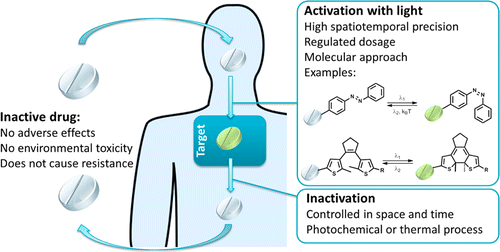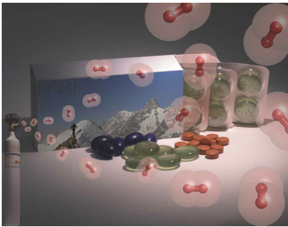Velema, W. A.; Szymanski, W.; Feringa, B.L. 2014.ASAP (perspective)
DOI: 10.1021/ja413063e
Pharmacotherapy is often severely hindered by issues related to poor drug selectivity, including side effects, environmental toxicity, and the emergence of resistance. Lack of selectivity is caused by the inability to control drug activity in time and space. Photopharmacology aims at solving this issue by incorporating photoswitchable groups into the molecular structure of bioactive compounds. These switching units allow for the use of light as an external control element for pharmacological activity, which can be delivered with very high spatiotemporal precision. This Perspective presents the reader with the current state and outlook on photopharmacology. In particular, the principles behind photoregulation of bioactivity, the challenges of molecular design, and the possible therapeutic scenarios are discussed.
Szymanski and Feringa described as “Perspective “about photopharmacology, which is the study of the effects of light and other radiations on drugs and on their pharmacological action.

The principle of photopharmacology is the introduction of a photoswitchable unit such as azobenzenes[1] and diary ethenes[2] into the molecular structure of the bioactive compound itself. Dynamic control is achieved through addressing a small, photo responsive molecule and, in a sense, is comparable to classical pharmacotherapy, making this method potentially interesting for medical applications. Specificity to the selected target is intrinsic to this approach, as it employs a highly optimized design of a selective, bioactive compound, into which a responsive element is introduced.
- Related references
[1] “Azobenzene photoswitches for biomolecules”
Beharry, A. A.; Woolley, G. A. Chem. Soc. Rev. 2011. 40, 4422. DOI: 10.1039/c1cs15023e
The photoisomerization of azobenzene has been known for almost 75 years but only recently
has this process been widely applied to biological systems. The central challenge of how to productively couple the isomerization process to a large functional change in a biomolecule has been met in a number of instances and it appears that effective photocontrol of a large variety of biomolecules may be possible. This critical review summarizes key properties of azobenzene that enable its use as a photoswitch in biological systems and describes strategies for using azobenzene photoswitches to drive functional changes in peptides, proteins, nucleic acids, lipids, and carbohydrates (192 references).
[2] “Diarylethenes for Memories and Switches”
Irie, M. Chem. Rev. 2000. 100, 1685. DOI: 10.1021/cr980069d


